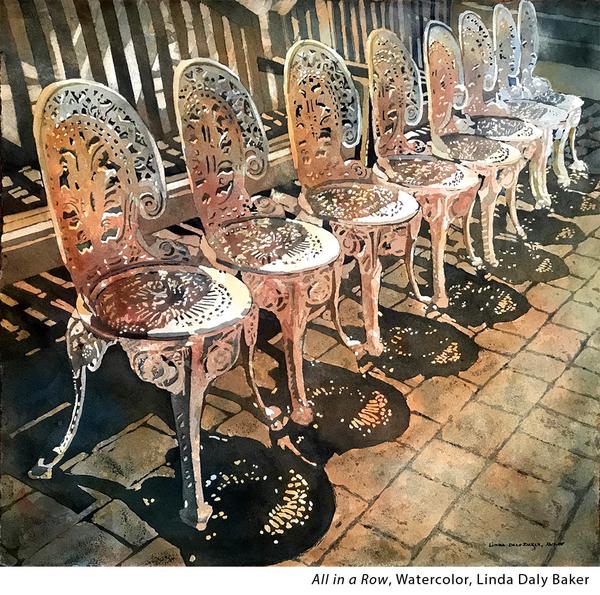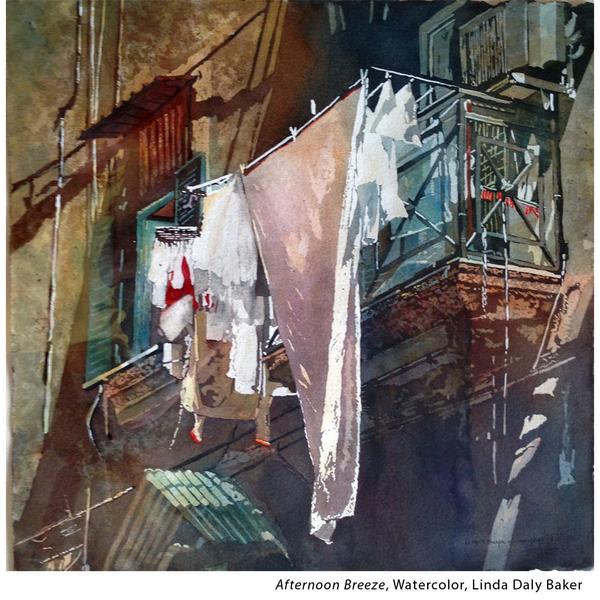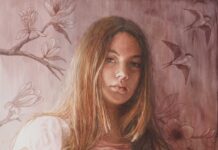“I tell my students that ‘failing to plan is planning to fail,’ says Linda Daly Baker. “I am a planner. Doing so isn’t necessarily required for everyone, but it’s the way I prefer to work.

“Planning a value sketch becomes a sort of road map for the fun process of pouring. If you do not work out the composition ahead of time, it is harder to get the elements you need later in the process. When starting with a sketch, you can fine tune your composition ahead of time.
“For example, preventing arrows leading the eye off the page, making sure the focal point is well placed, making certain all the corners are different, and so on. But more importantly than working out composition is defining a value pattern.
“Dominance of value is one of the most important considerations in the planning process. Knowing where you want light, mid, and dark ahead of time takes much of the guesswork out of painting. I sometimes say that I plan intensely so I can paint with abandon. If I short the planning stage, I will have to be much more conscious of the paint application and it will not be as fun. Painting with abandon is pure fun!”

THE ARTIST’S WATERCOLOR PAINTING PROCESS: POURING
“I start with an idea, work out a value sketch, and draw. Once I reach that point, I mask any small areas that I would like pure white, and then pour three liquid colors over the entire painting.
“I generally use a triad, and most often a pure blue, red, and yellow. When the colors mingle on the page, they can make the most amazing colors not to mention the design principles that get handled. This process will automatically give my painting unity, harmony, and a sense of order as an underpainting.
“After drying, I will repeat the process of applying more masking fluid and then pouring colors. Each layer gets a bit darker and more rich and the shapes that are covered with masking give it depth.
“When I have applied as many layers as I want, I remove all the masking with a rubber cement remover and then fine tune with direct painting and removing and scrubbing. Sometimes, I take off more than I add in terms of lost and found edges, and creating a bit of mystery but having some things less defined.”

UNDERSTANDING ART MATERIALS
“Because of my pouring process, it is very important for me to understand the qualities of the paints. Because I do so much layering, it is important that I pour with colors that are as transparent and translucent as possible. The more opacity a color has the bigger chance for a muddy buildup in the painting. I stay away from stainers because they are hard to correct and tend to grab the paper more than lay on the surface which is what I am attempting with my paint.
“Another thing that works well with my process is to pour with paints that are a bit less intense and save higher intensity paints for any direct paint finishing. Pouring with a less intense paint allows for more layers of thin luminosity without a heavy build-up of color.
“Brushes are important as I want a soft brush without much bristle action so as to not disturb the layers of pouring when I direct paint.
“Paper matters as a soft very absorbent paper does not work as well as a harder surfaced paper that can be more of a workhorse. All the pouring and sometimes extreme brushwork is hard on the paper and the sizing needs to hold up.”

Linda Daly Baker aims to capture the extraordinary light that transforms a subject almost to abstraction in her watercolors.








Your comments made me think why I have not had success. It’s not always the ability to draw but the quality of materials as well as the selection and tools used.
Some good information in the last 2/3 of the process portion that I hadn’t heard before. Thank you very much.